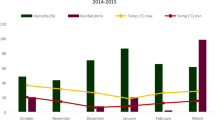Abstract
Fly ash (FA) from coal in Orissa (India) was used for amending soil at levels equivalent to 0, 1, 2.5, 5, 10 and 15 metric tons per ha in which, rice was grown and elemental residues of amended soil and plant parts were enumerated. FA amendments caused significant improvement in soil quality and germination percentage of rice seeds. Growth (shoot length, leaf area and pigment composition) and yield (panicle length, seeds per panicle, seed weight and yield per plant) of rice increased with an increase in FA amendments. Catalase and peroxidase activities of young leaves increased initially in plants cultivated at lower FA levels but declined sharply at higher FA levels while the protein content of seeds improved at higher FA levels. Sodium content of rice-roots did not change with FA amendments but the contents of K, P, Mn, Ni, Co, Pb, Zn, Cu, Cr, and Cd showed a progressive increase. Seeds of plants grown in FA amended soils accumulated Cu, Pb, Cr and Cd in amounts below allowable limits. Based on the data obtained we found that flooded-rice soil amended at 10 metric tons FA per ha level of FA not only improved the physical properties of the soil but also contributed to better growth and yield of rice.
Similar content being viewed by others
References
Brown S, Chaney RL (2000) Beneficial uses flue gas de-sulfurisation by-products: examples and case studies of land application. In: Dick WA et al. (eds) Land application of agricultural, industrial, and municipal by-products, SSSA Book series: 6, SSSA, Madison, WI, pp 343–360
Calmano W, Hong J, Forstner U, Hong J (1993) Binding and mobilization of heavy metals in contaminated sediments effected by pH and redox potential. Water Sci Technol 28:53–58
Camberato JJ, Vance ED, Someshwar AV (1997) Composition and land application of paper manufacturing residuals. In: Rechcigl J, MacKinnon H (eds) Agricultural uses of by-products and wastes. ACS, Washington DC pp 185–203
Davies BE (1992) Inter-relationships between soil properties and the uptake of cadmium, copper, lead and zinc from contaminated soils by radish (Raphanus sativus L.). Water Air Soil Pollut 63:331–342
Dick WA, Hao Y, Stehouwer RC, Bigham JM, Wolfe WE, Adriano D, Beeghly JH, Haefner RJ (2000) Benificial uses of flue gas desulfurization by-products: examples and case studies of land application. In: Dick WA et al. (eds) Land application of agricultural, industrial, and municipal by-products, SSSA Book series: 6, SSSA, Madison, WI, pp 505–536
Dubois M, Gilles KA, Hamilton JK, Rebers PA, Smith F (1956) Colorimetric method for determination of sugars and related substances. Anal Chem 28:350–356
Fytianos K, Katsianis G, Triantafyllou P, Zachariadis G (2001) Accumulation of heavy metals in vegetables grown in an industrial area in relation to soil. Bull Environ Contam Toxicol 67:423–430
Hemalata S, Francis K (2000) Lead inhibition of paddy leaf nitrate reductase. J Environ Biol 21:355–357
Korcak RF (1995) Utilization of coal combustion by-product agriculture and horticulture. In: Karlen D L et al (eds) Agricultural utilization of urban and industrial by-products. ASA Spec Publ 58, ASA, CSSA, and SSSA, Madison, WI, pp 107–130
Lowry OM, Rosenbrough NJ, Farr AI, Randall RL (1951) Protein measurement with the folin phenol reagent. J Biol Chem 194:245–275
Maehaly AC, Chance B (1967) The assay of catalase and peroxidases. In: Glick D (ed) Methods of Biochemical Analysis, Vol 1. Interscience Publishers, New York, pp 357–427
Marchner H (1995) Mineral nutrition of higher plants.Academic press, New York, pp 1–260
Miller DM, Miller WP, Dudka S, Sumner ME (2000) Characterization of industrial by-products. In: Dick WA et al. (eds) Land application of agricultural, industrial, and municipal by-products, SSSA Book series: 6, SSSA, Madison, WI, pp 107–119
Mishra M, Sahu RK, Padhy RN (2005) Effect of vermicomposted municipal solid waste on growth, yield, and heavy metal contents of rice (Oryza sativa). Fresenius Environ Bull 14:584–590
Mishra LC, Shukla KN (1986) Effects of fly ash deposition on growth, metabolism and dry matter production of maize and soybean. Environ Pollut (series A) 42:1–13
Piper CS (1944) Soil and Plant analysis. Inter Sci Publishers, New York,
Shane BS, Littman CB, Essick LA, Gutemann WH, Doss GJ, Lisk DJ (1988) Uptake of selenium and mutagens by vegetables grown in fly ash containing green house media. J Agr Food Chem 36:328–333
Walkley YA, Black IA (1934) An examination of digestion method for determining soil organic matter and a proposed modification of the chromic acid titration method. Soil Sci 37:29–38
Warren CJ, Dudas MJ (1988) Leaching behavior of selected trace elements in chemically weathered alkaline fly ash. Sci Total Environ 76:229–246
Acknowledgements
We thank Prof. S. C. Nayak, Principal, Govt. Autonomous College, Bhawnipatna for his encouragement and Director R.R.L., Bhubaneswar, for facilitating elemental analyses. We are grateful to Prof. Sadananda Naik for his help during the preparation of the manuscript. M. Mishra thanks Mr. Ashok K. Mishra, Principal, Kesinga Mahavidyalaya, Kesinga for his timely help and co-operation.
Author information
Authors and Affiliations
Corresponding author
Rights and permissions
About this article
Cite this article
Mishra, M., Sahu, R.K. & Padhy, R.N. Growth, yield and elemental status of rice (Oryza sativa) grown in fly ash amended soils. Ecotoxicology 16, 271–278 (2007). https://doi.org/10.1007/s10646-006-0128-7
Received:
Accepted:
Published:
Issue Date:
DOI: https://doi.org/10.1007/s10646-006-0128-7




